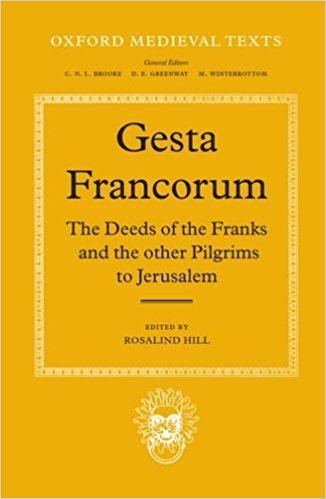7.8 /10 1 Votes7.8
Originally published 1100 | 3.9/5 Goodreads | |||||||||||||||||||||||||||||||||
 | ||||||||||||||||||||||||||||||||||
Similar Dei gesta per Francos, Alexiad, Historia Ierosolimitana, Historia Hierosolymitana (1095‑1127), A History of the Crusades | ||||||||||||||||||||||||||||||||||
Monday 6 24 13 gesta francorum session 1
The so-called Gesta Francorum ("The Deeds of the Franks") or in full Gesta Francorum et aliorum Hierosolimitanorum ("The deeds of the Franks and the other pilgrims to Jerusalem") is a Latin chronicle of the First Crusade written in circa 1100-1101 by an anonymous author connected with Bohemond I of Antioch.
It narrates the events of the First Crusade from the inception in November 1095 to the Battle of Ascalon in August 1099. The name of the author is unknown, but he was a member of the crusading party, either Norman or Italian, recruited by Bohemond of Taranto in 1096 from the duchy of Apulia. His narrative of the trip to Jerusalem, initially under the leadership of Bohemond and then Raymond of Toulouse, was composed and written during the journey. He had the help of a scribe who made occasional edits of his own, and thus the chronicle provides invaluable viewpoints of a knight who was not a high level leader or cleric.
The most important historical contribution is the day-to-day events of the journey: tactical operations, provisioning, changing moods of the crusaders, the anti-Greek prejudice, and progress of each day.
To his literary contemporaries, the anonymous author was a "rustic". Guibert of Nogent wrote his Dei gesta per Francos (1108) based on it, saying the original "frequently left the reader stunned with its insipid vacuity". Robert the Monk of Rheims was later commissioned to re-write the entire work for literary and historical improvements while Baudri of Dol also later re-wrote a version of "this rustic little work". However the original has persisted and today it remains one of the most valuable contemporary sources of the First Crusade.
Steven Runciman writes of the Gesta:
.... the author was a simple soldier, honest according to his lights but credulous and prejudiced and a strong admirer of Bohemond .... who hawked it round Northern France during his visit there in 1106. .... it was republished by Tudebod .... and about 1130 in the Historia Belli Sacri, a clumsy compilation using other sources eg Radulph of Caen. .... The Gesta was several times rewritten; in about 1109 by Guibert of Nogent, who added personal information and borrowed from Fulcher and who aimed at a more critical and moral tone; in about 1110 by Baudri of Bourgueil, Archbishop of Dol, who sought to improve its literary style; and by Robert of Rheims, whose popular and somewhat romantic version, the Historia Hierosolymitana, appeared in about 1122. It also inspired a short anonymous Expedition contra Turcos, and the chapters on the Crusades in the chronicles of Hugh of Fleury and Henry of Huntington.